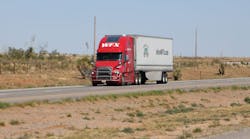ATLANTA. The North American Council for Freight Efficiency (NACFE) Run On Less program, in which Class 8 trucks drove tens of thousands of long-haul miles while testing fuel efficiency in 2017, will return this year but in a regional format.
In a press conference held during the Technology & Maintenance Council (TMC) event in Atlanta, Mike Roeth, executive director of NACFE, outlined how the 2019 event will differ from the one two years ago.
“In 2017 Run on Less hit the highway to see what kind of fuel economy could be achieved by seven experienced drivers of Class 8 heavy-duty tractor trailers,” he said. “They used existing technologies and performed their usual duty cycles. After 99 days of driving and 50,000 miles covered, the drivers achieved an average of 10.1 mpg.
“With Run on Less Regional, we’re looking at a different segment of the marketplace, with more diverse duty cycles, which will bring different challenges for the drivers to perform, and different technologies that they’ll be deploying on the tractor trailers.”
The particulars of Run On Less 2019 include:
- Three-week, cross-country roadshow showcasing advancements in freight efficiency;
- Will involve 10 regional haul participants;
- Will demonstrate a variety of commercially available freight efficiency technologies;
- Will provide real-time vehicle monitoring and reporting;
- Will highlight emerging technologies, not yet commercially available; and
- Results will be published in March 2020.
“It’s the Top Gun pilots of the trucking industry getting together, sharing tips, sharing how they do things, and the technologies their fleets use that maybe others do not use,” said Dave Schaller, industry engagement director, NACFE. “So that’s really neat to see our industry get together and focus on drivers and what they want. We look forward to doing that again with day cabs and regional operations.”
Run On Less will take place Oct. 8-25, in the U.S. and Canada. Regional specifics differ in many respects from the 2017 event.
“The primary requirement is that a truck remains within a 300-mile radius of their base,” explained Roeth. “They may go out and back. So you can envision a daycab tractor going out 250 miles, dropping their freight or maybe the driver unloading the freight for a few hours, and then returning. We may also see a truck that could be out for the whole week, but it stays in a region. It may do a drop in Columbus, OH, the goes to Toledo, then to Cincinnati, then over to Youngstown, or something like that.
“The truck is out, and the driver sleeps in it. We also believe there are duty cycles where some regional haul drivers may sleep in a hotel occasionally. So it’s not only out and back. And we’re looking for disparate routes.
“It’s part of not wanting to repeat what we did in 2017 but to do something new. We will real-time monitor the data off the truck as well as wind speed and those sorts of things. We also have challenges on the metrics that are different in regional haul compared to long haul. It will continue to be real freight, real trucks, real drivers, real routes.”
Roeth added that the event is planned for diesel fuel, but natural gas has not been ruled out. “A requirement is there must be commercially available fuel so we’re excluding electric trailers.”
There will likely be a lower mpg for the regional test than there was for long haul.
“I think it will be lower with all the starts and stops and fuel needed to get up to speed,” he said. “We’re wondering if we should be measuring something else, like a productivity measure. There is work to do to figure out metrics and goals. We are also wondering if we’re seeing a change in trucking to more freight being moved regionally, with things like e-commerce, and truckers wanting to be closer to home. Big fleets are saying they can’t even hire drivers to talk about being out two to three weeks. So they’re trying to get them home every week.”
NACFE is currently looking for fleets to take part in Run On Less. They should have demonstrated high efficiency through data-driven adoption of technologies and practices. The runonless.com website has a regional section fleets can visit to make contact.
“There are three reasons fleets should participate,” said Roeth. “First is to benchmark their efforts by being part of the best of the best leading up to and during the event. Second is to help the rest of the industry take advantage of what they have learned and third, and maybe most important, is to walk the talk — prove to the industry you are delivering the goods in a more sustainable manner.”



